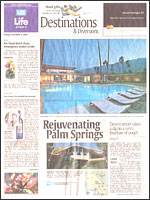 USA Today, Destinations an Diversions Section
USA Today, Destinations an Diversions Section
December 2, 2005
Rejuvenating Palm Springs…
Desert Resort takes a Dip in a Retro Fountain of Youth
Excerpt by Jayne Clark
Palm Springs, CA – Inside the Elvis Honeymoon Hideaway, caretaker/tour guide Laura Ramstead weaves through the asymmetrical rooms, all but oblivious to the fuzzy blown-up photos of the King, the leather-jacketed mannequin and the ’60s-style jukebox.
Instead, she’s focusing on the architectural details that inspired editors at Look Magazine to splash the dwelling on a 1962 cover and proclaim it The House of Tomorrow. “It’s been like pulling teeth to get Elvis to leave the building,” Ramstead says with a laugh, as she points out peanut-brittle stone walls, a free standing conical fireplace, terrazzo floors and other features that make the place an icon of swinging ’60s modernism.
The Elvis connection (he leased it for a year in 1966 and honeymooned here in 1967) still gets top billing. But increasingly, visitors are drawn to the house as a hallmark of mid-century modern architecture, a style that shaped Palm Springs from the 1940s to the ’60’.
A revived interest in that sleek, bold style has brought new vitality to this desert resort city of 45,000, once considered God’s waiting room. Now, after years of languishing touristically, Palm Springs is heating up with a passel of re-invented lodgings and new restaurants that are drawing a younger hipper crown. “We’ve played on the past for so long,” says Mark Bellinger, head of the local tourism bureau. “Now we want to go after a younger demographic”.
“So it’s a bit ironic that what’s attracting that younger demographic is, in many cases, a retro style exuberantly showcased in a growing number of lodgings.
Hotels Get a Glam Makeover
The Viceroy Palm Springs, whose bungalows housed Clark Gable and Carol Lombard back when it was Estrella Inn, has re-emerged in high-glam Hollywood regency style. And at dozens of small hotels, such as the Orbit In and the Movie Colony Hotel, hipsters with a taste for Eames-style chairs and blond wood furniture gather poolside for cocktail hour.
Dramatic Change
Beyond the spate of hotel makeovers are other developments designed to attract a crown including a striking copper and stone addition to the city’s convention center. In January, Cirque du Soleit-style performances debut in a new tented pavilion in the heart of downtown. And new shops are gradually moving into formerly shuttered storefronts on North Palm Canyon.
The dining scene is looking up, too, with a handful of chef-owned restaurants opening in the past two years. “It was horrendous five years ago,” says Jeff Hocker, a local marketing expert. “It was mostly steak and martini places and hadn’t really changed since the 1940s. But there’s been a dramatic change.”
Still, in its current incarnation, Palm Springs is more about ambience and attitude than activity. Committed golfers hole up in the newer “down valley” resort communities of Palm Desert, Indian Wells and Rancho Mirage, which in recent times eclipsed this city as a retreat for wealthy retirees and tourists alike.
Here, however, visitors lounge around the swimming pools that are the crown jewel of every hotel, whether it has nine rooms or 90. They linger at outdoor cafes along Palm Canyon Drive, the main drag of the compact, pedestrian-friendly downtown. Or wander through art galleries and shops specializing in mid-century modern furniture and accessories. It wasn’t always this way. With its spectacular setting in the shadows of the San Jacinto Mountains, dry sunny weather, natural mineral springs and proximity to Los Angeles two hours away, the area became a retreat for the Hollywood glamour set as early as the 1920s and ’30s. Cocktail culture was in full swing in the ’50s and ’60s with celebrities such as Bing Crosby, Frank Sinatra and Dean Martin lounging by the pool, along with wealthy Easterners and Midwesterners and a growing middle class.
But in the 1970’s and ’80’, the city had reached a nadir in the boon-and-bust cycle experienced by some resort areas. Economic doldrums prompted an exodus, and some who stayed couldn’t afford to maintain their homes. The moneyed set moved to newer resort communities in the Coachella Valley. And much of Palm Springs proper “was becoming a ghost town,” says Robert Imber, who operated Palm Springs Modern Tours. “All this architecture was left to decay until it was rediscovered in the late ’80s and early ’90s.” Hundreds of atomic-era gems were constructed between the 1940s to1960s by modernist architects including Richard Neutra, Albert Frey, Donald Wexler, William F. Cody and E. Stewart Williams. They put their stamp on the city with hundreds of sleek, rectilinear buildings of glass, steel, aluminum and concrete.
In the past decade, the city blossomed as a modernist mecca when buyers came seeking homes built in the post-World War II boom years by the father-son team of George and Robert Alexander. The duo constructed upwards of 2,500 homes (including what came to be known as the Elvis Honeymoon House) that were marked by wood post-and-beam construction, open floor plans and floor-to-ceiling windows that brought the outdoors in.
That interest sparked a mini tourism boom, says Jay Ramstead, co-founder of the town’s small hotel association. “Half the clientele weren’t necessarily coming to experience Palm Springs. They were here to hook up with real estate agents. And that interest in housing has helped fuel the hospitality industry”.
Indeed, investors began buying up long-neglected small hotels, (many of which has been converted to apartments), attracting a youthful clientele with an appreciation for irony, as well as older baby boomers with a nostalgia for mid-century modern trappings.
“A lot of people are comfortable with this style,” says Ramstead. “Somewhere in their past is one of those pink-tiled bathrooms.”
